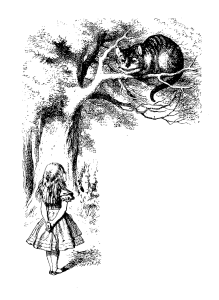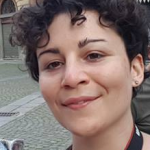Once upon a time, a little girl arrives in an enchanted land named Bio-land. Her name is Alice. Are you curious about her? Take a look at this: Alice in “Bio-Land”: Engineering Challenges in the World of Life Sciences (Benso et al., IT Professional, vol. 16, July-Aug. 2014). By the way, since her arrival, the fascination for that strange place and the creatures living there grows second after second. But she finds herself unable to comprehend fully neither the very nature of the phenomena taking place, nor the way the biologists, a species of local creatures, are studying such events. Thus, she desires to learn the peculiar language they use to codify and share their results. But the little girl keeps finding herself in situations very difficult to understand using her way of thinking. Everything seems to work exactly backwards respect to her expectations.
If Alice had the opportunity to tell her story, she would begin saying that she is trying hard to exploit and value her engineering skills for figuring out how things function there, but nobody seems to understand or appreciate. Biologists seem busy trying to make sense of very little pieces of the land all the time. They have methods and procedures she finds too loose. They communicate poorly between them. And they do not produce detailed sketches of their very interesting findings. That’s a pity, because she thinks that if only she could share her know-how she could help them and they could help her to better understand the seemingly magical phenomena of Bio-land. Do biologists lack method and specificity, or are their ways optimal for something she does not comprehend fully? Everything would be easier if she could just understand the biologists and be understood by them.
At some point, she starts wandering in one of the woods of the land, crowded with strange creatures having surprising colours and behaviors. Yet, every creature is at least partly hidden in the dense vapor: she can not figure out any shape completely. Suddenly, something captures her attention. A wide grin has appeared right in front of her, fluctuating in the air over the branch of a tree, unveiled by the mist. In a few moments, a cat takes shape around the two rows of shining teeths. Alice realises the first thing she could see in its entireness since she arrived there was actually a part of something else. Quite ironic. That “something” is now lying on the branch, with its tail moving at a constant and slow pace. A huge cat with an enormous grin. Alice feels like she got lost since she arrived in Bio-land.
 Staring at the big cat, she asks:
Staring at the big cat, she asks:
– Would you tell me, please, which way I ought to go from here?
– That depends a good deal on where you want to get to – says the Cat.
– I don’t much care where– says Alice.
– Then it doesn’t matter
which way you go – says the Cat.
–so long as I get SOMEWHERE,- Alice adds as an explanation.
– Oh, you’re sure to do that – says the Cat – if you only walk long enough. –
Just like the fog surrounding it, the cat fades out on the wings of the breeze, and while pronouncing the last words it completely disappears. Alice remains in front of the tree, while the mist is carried away as well. A diversity of crossing paths across the woods appears. Suddenly the strange inhabitants of the woods are unmasked. Their unusual shapes make Alice want to know even more about them. She was lost in a land of uncertainty, and now she finds herself in the middle of a land of possibilities. Something tells her the more she will wander before beginning to sketch her projects, the more her design will be real in Bio-land. Where does she want to go? Her intuition suggests that for comprehending the complexities of that realm she needs to learn from that big cat. That strange animal evidently comprehends the fog of uncertainty very well, since it is capable of fading in and fading out just like the vapor itself would do. But how to accomplish that? While pondering such questions, she unconsciously starts to wander along one of the paths. After a while, a biologist approaches her. For the first time since she arrived there, someone asks for her help. He says her sketches seem great, she seems to hold very powerful tools in her pocket, she is probably able to provide for a great help in his research. He asks Alice how did she chose that particular way, in the woods. But she doesn’t know: she just started to wander… A fruitful collaboration begins, like it could have begun along any of the paths in front of Alice’s eyes.
This is a tale of paradoxical decision making processes and serendipitous encounters. Like many other stories lying at the interface between different worlds, it develops around conflicts and resolutions. If characters take a step in the direction of what is alien to them, a new world of possibilities takes shape. The important thing is to learn – or to invent – a common language.With the next posts we will explore some of the possible encounters between the world of engineers and that of biologists. I claim that the boundaries between these two realms are semi-permeable. That produces diverse interesting combinations of constraints and possibilities. An interesting and diverse world takes shape at the interface.
It is possible to observe such matters under different lenses. For instance, on one side we have the engineer’s top-down approach to objects to be designed. On the other hand, biologists use to study living systems by reverse engineering, following a bottom-up approach common to experimental natural sciences in general. That is a large cultural gap, and bridging its two ends in different ways is a very interesting challenge. The two approaches come with very different orders of complexity: the degrees of freedom of a controlled system where most variables are known are way lower than those emerging from the study of a biological phenomenon. A system structured by design ideally tends to deterministic behaviour. Conversely, for explaining at least partly some biological phenomena we need to include stochasticity, since mechanistic explanations are often not covering the whole story. We can also engage in games of symmetry. Biological entities can be modified and assembled by a forward engineering approach. Conversely, artificial designs can imitate models obtained by reverse engineering biological systems.
We intend to wander in this realm at the interface between biology and engineering, being open to any serendipitous encounter we could make. Just the way Alice would do – and the Cheshire Cat is possibly doing since ever.
 Roberta Bardini
Roberta Bardini
